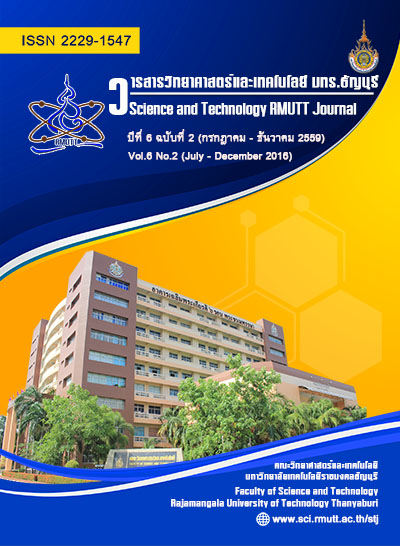Detection of Markers on Runway and Conversion to 3D Information for Automatic Landing Using Computer Vision
Main Article Content
Abstract
This research proposes the design and implementation of an automatic landing assistant system of fixed-wing unmanned aerial vehicle (UAV) using a computer vision. The researchers are using a camera attached to the UAVs for the estimation between the position and runway which has two majors. First, the detected left - right stripes of runway use Threshold and Hough Transform. Second, the detected green dot symbol on the runway use linear algorithm which is Homography and Direct Linear Transform for accurate comparison. The result of the detection of the white left - right stripes of runway found that a detected border of the runway as well and the results of the detection using the green dot symbol found that the result of the Homography algorithm near to real value more than Direct Linear Transform algorithms.
Article Details
References
Byoung-Mun Min et al., “Guidance Law for Vision-Based Automatic Landing of UAV,” KSAS International Journal, vol. 8, no. 1, May 2007.
Andrew Miller et al., “Landing a UAV on a Runway Using Image Registration”, IEEE International Conference on , Robotic and Automation , 19-23 , May , 2008, California, USA .
P. K. Menon et al., “Robust Landing-Guidance Law for Impaired Aircraft,” Journal of Guidance Control, And Dynamics, vol. 35, no. 6, 2012.
James et al., “Vision Based Algorithm for Automatic Landing System of Unmanned Aerial Vehicles,” International Journal of Innovation Science, Engineering & Technology, vol. 2, issue 4, 2015.
Gregory Taubel et al., “An Experimental Study of a Lane Departure Warning System Based on the Optical Flow and Hough Transform Methods,” WSEAS Transaction on Systems, vol. 13, 2014.
Li Sha Sha, “The Research of the Lane Detection Algorithm Base on Vision Sensor,” Research Journal of Applied Sciences, Engineering and Technology, Maxwell Scientific Organization, 2013.
Mehmet Miman et al., “Lane Departure System Design using with IR Camera for Night-time Road Conditions,” TEM Journal, vol. 4, 2015.
King Hann LIM et al., “Lane Vehlcle Detection and Tracking,” International MutiConference of Engineers and Computer Scientists, 18 – 20 , March , 2009, Hong Kong.
Nasim Arshad et al., “Lane Detection with Moving Vehicles Using Color Information,” International MutiConference of Engineers and Computer Scientists, 19-21 , October , 2011, San Francisco, USA.
Thanda Aung et al., “Video Based Lane Departure Warning System using Hough Transform,” International Conference on Advances in Engineering and Technology, 29-30 , March ,2014, Singapore.
Zhengyou Zhang, "Flexible camera calibration by viewing a plane from unknown orientations, " IEEE International Conference on Computer Vision, 20 ,September , 1999, Greece.
9 Degrees of Freedom - Razor IMU - AHRS compatible : http://www.sparkfun.com/products/9623.
O. Faugeras, “Three-Dimensional Computer Vision,” A Geometric Viewpoint, The MIT Press, 1993.
Lane departure warning system : http://www.mathworks.com/help/vision/examples/lane-departure-warning-system.html.
Cockpit view of approach and landing at edinburgh airport : https://www.youtube.com/watch?v=SHby1wclrw0.
Muangmol Senpheng et al., “Automatic landing assistant system based on stripe lines on runway using computer vision,” International Conference on Science and Technology, 4-6, November, 2015, Pathum Thani, Thailand.


